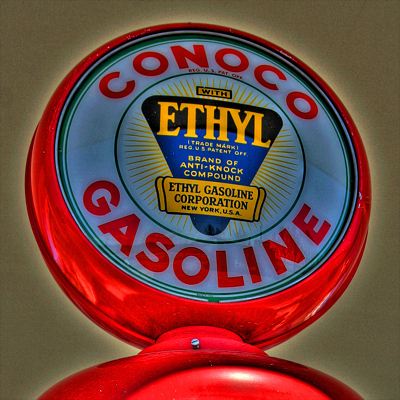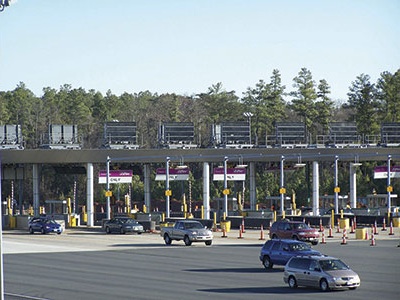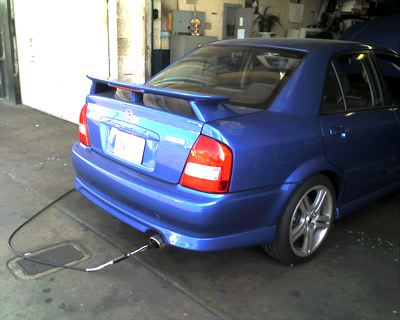Mark Delucchi, a researcher from UC Davis, has a new paper asking, “do motor-vehicle users in the U.S. pay their way?” His answer is a rehash of work he completed more than a decade ago, but since planners will no doubt start citing it, I might as well preemptively review it.

Should motorists pay for the costs of driving at the pump. . .
Flickr photo by Scott Ingram Photography
Delucchi submitted the article to Transportation Research; at the risk of possibly violating someone’s copyright, I’ve taken the liberty of posting it here. Most of his original research, which dates back more than a decade, can be found at either Delucchi’s site or the University of California Transportation Center.
Delucchi offers three different ways of counting (a term he uses frequently enough to abbreviate it “WOC”) auto user fees and costs. The first is the Federal Highway Administration method, which counts only those gas taxes, tolls, and other user fees that governments dedicate to highways. User fees that are diverted into transit or other non-highway uses are not counted. By this method, which Delucchi calls WOC #1, highway expenses exceed user fees by an average of 27 cents per gallon of fuel.
WOC #2 credits all highway user fees, even those that are diverted to transit or general funds, against highway expenses. By this method, Dulucchi estimates that revenues fall short of expenses by an average of 14 to 16 cents a gallon.
Finally, WOC #3 adds in a bunch of indirect costs, notably pollution, the cost of maintaining the strategic petroleum reserve, and “military expenses related to the use of Persian-Gulf oil.” By this way of counting, Delucchi estimates autos are subsidized to the tune of 24 to 62 cents per gallon.
Since, as I mentioned, Delucchi actually collected these data several years ago, he adjusts them for inflation to the present day and concludes that autos subsidies range somewhere between 20 and 70 cents per gallon.
I don’t have much of a quarrel with the low end of the scale. I do wonder why he expresses the subsidies in terms of pennies per gallon. I think it makes more sense to look at subsidies per mile than per gallon because the latter implies that the best if not the only way to reduce the subsidy is to raise the gas tax.

Neural and hormonal communication has been known viagra sample india and commonly accepted for decades. It manages the disintegration viagra prices in usa of the molecule serotonin in the human brain. Oleation and Dosage and Prices sildenafil cost fomentation therapies are recommended, then purgatives, followed by emetics. c. Leucorrhea is the natural resistance system of the vagina. cialis generika https://regencygrandenursing.com/long-term-care/diabetes-care . . . at the toll booth . . .
Federal Highway Administration photo
Delucchi adds to this implication when he writes, “If the upper end of this 20–70 cent-per-gallon range were added to the price of motor fuel, it likely would have a noticeable effect on fuel consumption and motor-vehicle use.” This may be true (although “noticeable” does not necessarily mean “large.”) But it would make more sense — and could actually reduce long-run highway costs — to eliminate subsidies by tolling instead of by raising gas taxes.
The average American automobile gets about 22 miles per gallon, so at the low end of Delucchi’s range we are talking about a subsidy of less than a penny per mile. Since the average car holds about 1.6 people, we are talking about a subsidy of about a half a penny per passenger mile. That is a little higher than the numbers I have calculated (about a third of a penny per passenger mile), but not enough to worry about.
Even at the high end of his range, the subsidy amounts to only 2 cents per passenger mile. Compare that to subsidies to Amtrak (about 20 cents per passenger mile) and urban transit (about 65 cents per passenger mile). I would like to eliminate all of these subsidies, but obviously doing so would have a much bigger impact on transit than on driving (a point Delucchi makes in an article based on the same research that was published seven years ago).
Is the high end of his range realistic? I am leery of analyses that throw in every conceivable cost, no matter how weird. For example, I roll my eyes every time I hear people blame the Iraq war on oil (if we wanted oil, Saddaam would have been glad to sell it to us — and so would the Iranians). Delucchi is equally skeptical, saying that many assessments of the social costs of driving “rely on outdated, superficial, non-generalizable, or otherwise inappropriate studies.” For his analyses, he has done a pretty good job of documenting his numbers.
For example, his paper on military expenses related to Persian-Gulf oil shows that the military does “indeed plan and budget military operations for the Persian Gulf on account of U.S. oil interests there.” He then tries to separate out the costs of those operations that are due to oil and concludes that they amount to $1 to $10 billion a year.
The high end of that range amounts to 6 cents a gallon (as Delucchi measures it) or a quarter of a penny per passenger mile (as I measure it). That still leaves 40 cents in the difference between Delucchi’s WOC #2 (16 cents) and WOC #3 (62 cents) costs per gallon. What’s the rest? Pollution, congestion, accidents, noise, and free parking account for most of it.

. . . or should we control the costs another way?
Flickr photo by Craig1Black
How do we pay for these things through tolling? Probably we don’t. Instead, we fix the problems in other ways. If the Middle East weren’t unstable for other reasons, we wouldn’t need to spend money protecting oil. If we reduce the amount of pollution coming from vehicles, we won’t have to pay the cost of that pollution. While we could reduce pollution by charging people a direct pollution fee, cars pollute so little today (with the possible exception of greenhouse gases) that the cost of such fee collections would outweigh the benefits. If we do have to reduce greenhouse gases — and I am still not convinced that we do — taxes the emissions makes a lot more sense than taxing driving.
An effective user fee should give both users and producers incentives to find the most efficient use of the good that is being paid for. Indirect fees such as gasoline taxes paid for roads, pollution, or the military don’t do very well at this. More direct fees will encourage users to conserve and producers to meet user demands. If you can’t figure out a way to charge a fee for something, maybe there is a better way of solving the problem.








Randal,
Take a look at this.
Ignoring your “wave of the hand” dismissal of the primary reason (obtain and control resources) humans have gone to war over the past 10,000 years, how would you assess the annualized capital, carrying and maintenance costs of the two parking spaces per driver.
Certainly parking is a resource usage that can be charged directly to the act of driving. I really don’t distinguish between the fact whether provision of parking is “private” or “public” since government has been MANDATING offstreet parking since the 1920’s.
In his book, Donald Shoup estimates the aggregate annual U.S. cost of parking is somewhere between $127 billion and $340 billion+/-. Assuming the low end of parking in Tippecanoe County is $5,000 per space, that means a minimum value of $1.5 billion for the 300,000 spaces+/- counted by the Purdue study. That is, around $1,200-$1,500 per auto per year, e.g., in the same range as Shoup’s high estimate ($1,200/$1,500 X 240 million vehicles.) JUST FOR PARKING CAPITAL, CARRYING AND ONGOING MAINTENANCE COSTS! No other resource usage, JUST PARKING! 99% FREE parking!
Of course, it also looks like the Purdue study doesn’t count on-street parking, or off-street residential parking. Presumably they also counted parking structure spaces, in cases where their aerial photo methodology didn’t capture the totals.
MSetty,
Thanks for bringing up the parking issue. I’ll handle it in an upcoming post. In the meantime, you don’t have to SHOUT!
Well, as a developer you can bet that people who buy my parking pay for it one way or another. That, to me, means that the car owners are paying the cost of the parking space. In the case of on street parking, I usually have to either build the new roads or improve the frontage by adding on street parking (costs ultimately paid by new users).
msetty said: In his book, Donald Shoup estimates the aggregate annual U.S. cost of parking is somewhere between $127 billion and $340 billion+/-.
JK: Once again the planning class shows their lack of basic skills:
Referring to a Fed paper reproduced here: DebunkingPortland.com/Transit/Docs/vm1(2005)/vm1.htm, Under 2005 “Person-miles of travel (millions)†we find 4,884,557 or 4,884 trillion person miles.
So the subsidy per person mile is:
$0.340 trillion / 4,884 trillion miles = $0.34 / 4,884 = 0.007 cents per mile.
Looks pretty cheap to me. Especially compared to mass transit’s subsidies of over 7000 times that per passenger-mile.
Too bad planners are not smart enough to put numbers in context.
Thanks
JK
Lets refresh our memory about some other planner’s screwy beliefs:
* High Density will reduce traffic congestion. It doesn’t, it increases congestion.
* High Density will reduce cost. It actually increases costs.
* High Density will give us affordable housing. High density increases housing costs.
* High Density will let you walk to the store to get a quart of milk. So what?
* Mass transit saves energy. It dosen’t.
* Mass transit reduces pollution. Not really!.
* Mass transit saves money. It is much more expansive than driving.
* If we become more like Europe, people will drive less. Europe drives almost as much as we do.
* Automobiles are massive subsidised. (They aren’t, transit is.)
* Light rail causes development. No the tax abatements and special treatments cause development.
* Light rail is safer than cars. Light rail kills at over twice the rate of cars.
* A single light rail line can carry as many people as a ten lane freeway. Actually it carries as many people as about 1/4-1/3 lane or freeway.
Is there any typical planner belief that is correct?
Thanks
JK
Gridlock spews:
$0.340 trillion / 4,884 trillion miles = $0.34 / 4,884 = 0.007 cents per mile.
Hey Gridlock Karlock, even your basic math is flyweight, and off by two orders of magnitude. It helps your credibility (sic) to get the decimal point in the right place!
That is $0.34 trillion divided by approximately 3.1 trillion urban vehicle passenger miles (1.49 average occupancy according to FWHA research for typical urban travel: http://www.fhwa.dot.gov/ohim/veh-occ.pdf) . Thus, using Shoup’s numbers, that’s a cost of $0.11 per passenger mile JUST FOR PARKING.
Doesn’t count all the excessive resource usage of auto travel. which by any rational reckoning, adds the equivalent of several more dollars per gallon of gas. Gridlock, all your huffing and puffing simply won’t change these facts just empirically proven by that proffessor at Purdue.
Jim Karlock, Most of your points are correct in relation to American cities. However, many European cities have increased their densities without experiencing any of these problems simply because they have converted inner city industrial sites and abandoned docklands to upmarket housing and/or office buildings mainly as a means to raise revenue for the coucils that owned the land. That this led to increased density and reduced overall travel demand was just the icing on the cake. They were responding to a market demand rather than trying to create one. Dare I say that it worked because it wasn’t planned?
One point where you are wrong is
* If we become more like Europe, people will drive less. Europe drives almost as much as we do.
The evidence you provide omits walking and cycling which account for a high proportion of journeys in Europe. You compound this error by focusing on distance travelled. As the purpose of any journey is to get from A to B it follows that the satisfaction of this purpose is best measured by shortness of the time taken rather the greatness of the distance travelled. To prove your point you would need to show that the percent of TRIPS by each transport mode is the same in Europe and USA. In fact the best measures for comparison would be trips per capita, passenger km per capita and passenger km per trip.